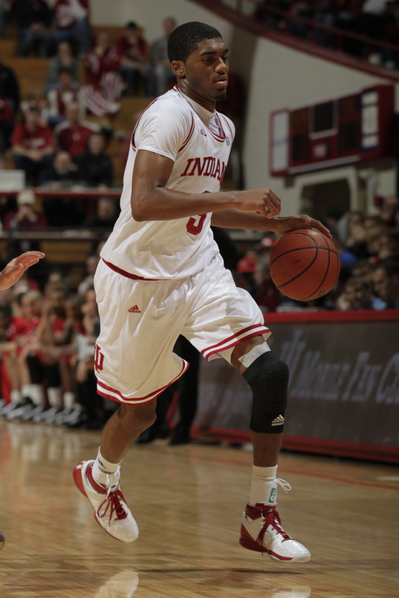The Curious Case Of Maurice Creek
Posted by jstevrtc on January 18th, 2011The Louisville Courier-Journal’s Rick Bozich — one of the friendliest pros we’ve run across in our travels, by the way — wrote yesterday that Indiana sophomore guard Maurice Creek suffered a stress fracture in his right kneecap during the Hoosiers’ game against Michigan on Saturday. If that sounds familiar, unfortunately it’s not because you’re experiencing a deja vu right now. During IU’s 12th game last last season (Bryant, on 12/28), Creek fractured his left patella and missed the rest of the year. It looks like he’ll have to shut it down for the rest of this season, now, too. You’re reading that correctly. That’s two kneecaps — each with a fracture.
As Mr. Bozich points out in the linked article (you have to click on it and read it, as we explain below), Creek was still showing the effect of last year’s injury in that he didn’t exhibit the same quickness on drives or the same spring we saw last year when jumping off the left leg. Before going out last season, Creek was leading Indiana in scoring (16.4 PPG), points per 40 minutes (25.8), and steals (1.4 SPG) in 25.4 minutes per game. This year (through this past Saturday), Creek was fifth on the team in scoring (8.3 PPG), sixth in PP40 (16.6), and was snagging only 0.2 SPG in an average of 20 minutes per game.

After 11 Games Last Year, Creek Looked Like a Sure One-And-Done. Now, He'd Prefer Just To Get Through a Whole Season At IU
The odd symmetry and style of Creek’s injuries got us thinking, and we’d like any kinesiologists out there (or anyone who knows about this stuff) to step up and bring some knowledge. Is there something about Creek’s running or jumping mechanics that makes him susceptible to such injuries? The mechanism of a patellar fracture is — just as you’d figure — usually a hard blow to the front of the knee. More rarely, you can fracture your kneecap by flexing your quads while the knee is totally bent. Bilateral kneecap breaks usually only happen in stories involving mobsters wielding baseball bats, or in traumas like falls or car crashes (which can also cause unilateral kneecap fractures, to be fair). Creek’s injuries involve two different knees at two different times, and neither of them is related to any blunt trauma to the knees. Is this coincidental?
If there is something about Creek’s body type, running, or jumping style that makes him more susceptible to patellar fractures, here’s another question: how long is it until a field of sports medicine and/or kinesiology exists in which properly trained persons can do a physical examination on an athlete, watch them perform basic athletic movements, and predict with some accuracy the likelihood of that athlete suffering certain types of injuries at a later age (i.e. in college or as a professional)?
We already live in an age in which thoroughbred trainers can simply look at a foal that’s been alive for less than a week and immediately see what kind of potential the animal has, based solely on physical appearance and running mechanics. Track and field coaches do this all the time, too. Many of them can look at a player’s running style or body type, see areas of inefficiency, and do their best to fix it. Athletes at professional combines are subjected to all sorts of tests and measurements that can predict certain aspects of later performance; heck, sometimes it’s even broadcast on television. Is there any data out there that suggests that those observations and measurements can predict possible injuries as well as predict future performance?
There would certainly be ethical questions if such things were possible. If your son or daughter was being recruited by top-drawer programs in a given sport, would you like it if a scout submitted a report to interested parties claiming that your athlete has a higher chance of an eventual ACL tear or dislocated shoulder and they should sign him/her at their own risk (mind you, these projections would be exactly that — predictions of things that might happen)? Or is this kind of thing already happening?
Whether or not such a field of study exists right now doesn’t mean anything to Maurice Creek. All he knows is that he’s probably out for the rest of the year after playing, yet again, somewhere around half of a season. And he knows that this isn’t his fault — he was just plaing as hard as he could. Obviously we still have to allow for the chance that his two patellar fractures are just a coincidence, but because it’s such an odd occurence, it’s appropriate to ask the question of whether or not there’s something about Creek’s style of play or his running or jumping mechanics that would cause him to have a higher probability of sustaining these injuries. And if someone could indeed have predicted it, we wonder how long it will be until every athlete is “pre-evaluated” in such a manner, even down to the high school level.
[Ed. Note: You should click on the link to Mr. Bozich’s article in the first paragraph not just to read his fine write-up, but also for the photo in the story. In no way are we making light of Creek’s misfortune, but when you have teammates standing over you with open mouths pointing at your injury (in this case, the one from last year), you know it’s not good. There’s nothing gruesome in the picture — it’s just a compelling shot.]









































